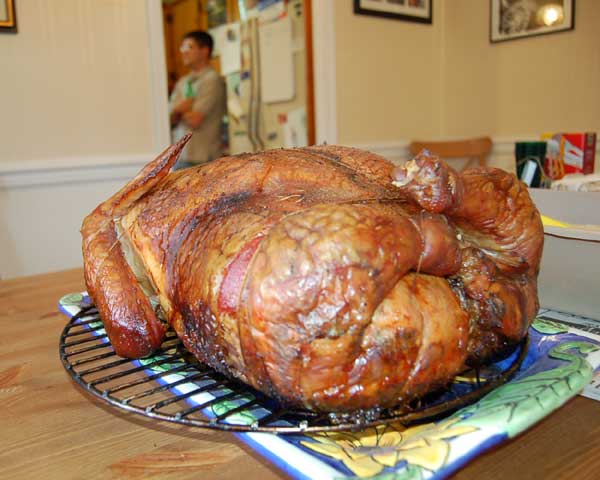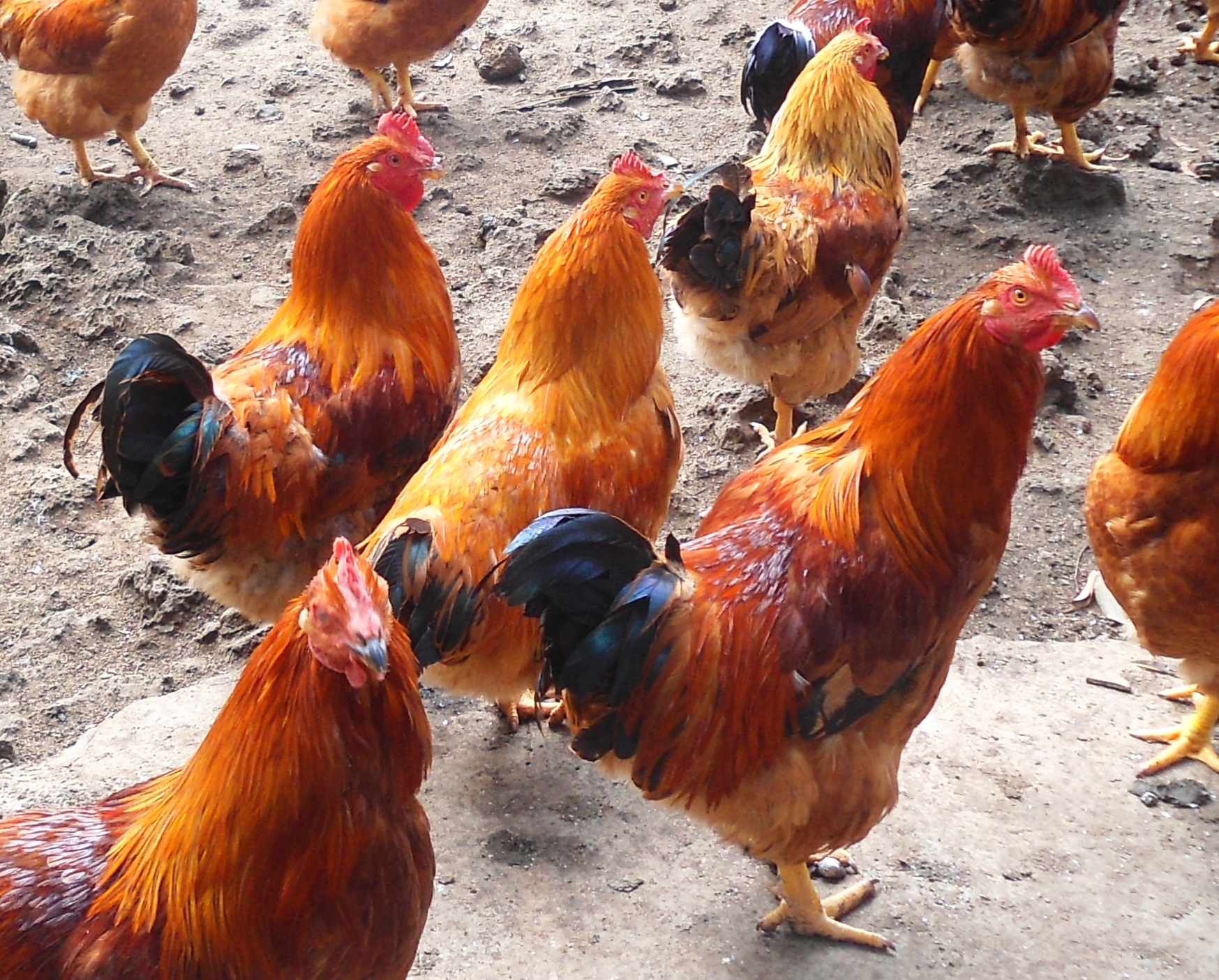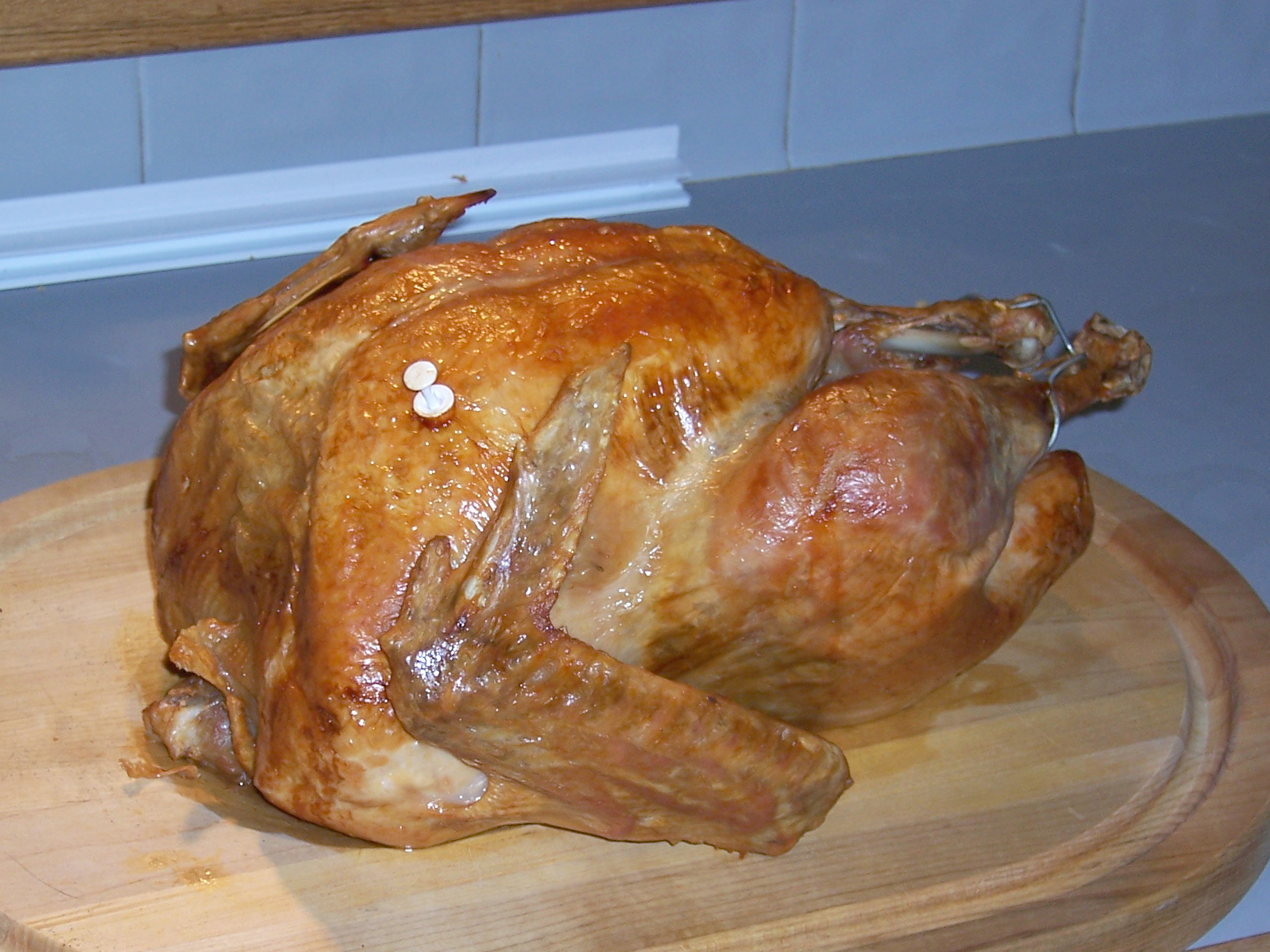|
Cockentrice
Cockentrice is a dish consisting of a suckling pig's upper body sewn onto the bottom half of a capon or turkey. Alternately, the front end (head and torso) of the poultry is sewn to the rump of the piglet to not waste the other half. Other animal combinations were also used. The cockentrice was basted with a mixture of egg yolk and saffron during the roasting or covered with gold foil; it was also filled with a similar mixture to have a gilded inside. The dish originates from the Middle Ages and at least one source attributes the Tudor dynasty of the Kingdom of England as its originator. Nomenclature Cockentrice, at times also spelled ''cockentryce'', is only one version of the dish's name. The original name was ''cokagrys'' or ''cotagres'', a portmanteau of "cock" and ''grys'', a suckling pig. Other spellings from the period include ''koketris'', ''cocagres'' and ''cokyntryche''. See also *Engastration * Turducken *Kiviak * List of meat dishes This is a list of notable meat ... [...More Info...] [...Related Items...] OR: [Wikipedia] [Google] [Baidu] |
List Of Meat Dishes
This is a list of notable meat dishes. Some meat dishes are prepared using two or more types of meat, while others are only prepared using one type. Furthermore, some dishes can be prepared using various types of meats, such as the enchilada, which can be prepared using beef, pork or chicken. Meat dishes The following meat dishes are prepared using various types of meats, and some are prepared using two or more types of meat in the dish. * Anticucho – popular and inexpensive dishes that originated in the Andes during the pre-Columbian era. While anticuchos can be made of any type of meat, the most popular are made of beef heart (anticuchos de corazón). * Asocena * Baeckeoffe – a French casserole dish prepared using mutton, beef and pork * Barbacoa * Berner Platte – a traditional meat dish of Bernese cuisine in Switzerland. It consists of various meat and sausage varieties such as smoked pork and beef, pork belly, sausage, bacon and pork ears or tails cooked with jun ... [...More Info...] [...Related Items...] OR: [Wikipedia] [Google] [Baidu] |
Turducken
Turducken is a dish consisting of a deboned chicken stuffed into a deboned duck, further stuffed into a deboned turkey. Outside of the United States and Canada, it is known as a three-bird roast. Gooducken is an English variant, replacing turkey with goose. The word ''turducken'' is a portmanteau combining ''turkey'', ''duck'', and ''chicken''. The dish is a form of engastration, which is a recipe method in which one animal is stuffed inside the gastric passage of another—twofold in this instance. The thoracic cavity of the chicken/game hen and the rest of the gaps are stuffed, sometimes with a highly seasoned breadcrumb mixture or sausage meat, although some versions have a different stuffing for each bird. The result is a fairly solid layered poultry dish, suitable for cooking by braising, roasting, grilling, or barbecuing. [...More Info...] [...Related Items...] OR: [Wikipedia] [Google] [Baidu] |
Suckling Pig
A suckling pig is a piglet fed on its mother's milk (i.e., a piglet which is still a "suckling"). In culinary contexts, a suckling pig is slaughtered between the ages of two and six weeks. It is traditionally cooked whole, often roasted, in various cuisines. It is usually prepared for special occasions and gatherings. The most popular preparation can be found in Spain and Portugal under the name ''lechón'' (Spanish) or ''leitão'' (Portuguese). The meat from suckling pig is pale and tender and the cooked skin is crisp and can be used for pork rinds. The texture of the meat can be somewhat gelatinous due to the amount of collagen in a young pig. History There are many ancient recipes for suckling pig from Roman and Chinese cuisine. Since the pig is one of the first animals domesticated by human beings for slaughter, many references to pigs are found in human culture. The suckling pig, specifically, appears in early texts such as the sixth-century Salic law. As an example of ... [...More Info...] [...Related Items...] OR: [Wikipedia] [Google] [Baidu] |
Capon
A capon (from la, cāpō, genitive ''cāpōnis'') is a cockerel (rooster) that has been castrated or neutered, either physically or chemically, to improve the quality of its flesh for food, and, in some countries like Spain, fattened by forced feeding. History The origins of caponised chickens are contested. They were known in ancient China as well as in ancient Greece and ancient Rome. An early record of caponisation is found under the Roman Republic: the Lex Faunia of 162 BC forbade fattening hens to conserve grain rations, so the Romans instead castrated roosters, which resulted in a doubling of size. It was also practiced later throughout medieval times, with gastronomic texts describing capons as preferred poultry since the ordinary fowl of the farmyard was regarded as peasant fare and "popular malice crediting monks with a weakness for capons." France is internationally renowned for maintaining a strong caponisation tradition with widespread and established indu ... [...More Info...] [...Related Items...] OR: [Wikipedia] [Google] [Baidu] |
Turkey Meat
Turkey meat, commonly referred to as just turkey, is the meat from turkeys, typically domesticated turkeys but also wild turkeys. It is a popular poultry dish, especially in North America, where it is traditionally consumed as part of culturally significant events such as Thanksgiving and Christmas, as well as in standard cuisine. Preparation and production Turkeys are sold sliced and ground, as well as "whole" in a manner similar to chicken with the head, feet, and feathers removed. Turkeys "crowns" are the breast of the bird with its legs and wings removed. Frozen whole turkeys remain popular. Sliced turkey is frequently used as a sandwich meat or served as cold cuts; in some cases where recipes call for chicken, it can be used as a substitute. Ground turkey is sold, and frequently marketed as a healthy alternative to ground beef. Without careful preparation, cooked turkey is usually considered to end up less moist than other poultry meats such as chicken or duck. Wild ... [...More Info...] [...Related Items...] OR: [Wikipedia] [Google] [Baidu] |
The Atlantic
''The Atlantic'' is an American magazine and multi-platform publisher. It features articles in the fields of politics, foreign affairs, business and the economy, culture and the arts, technology, and science. It was founded in 1857 in Boston, as ''The Atlantic Monthly'', a literary and cultural magazine that published leading writers' commentary on education, the Antislavery Movement In America, abolition of slavery, and other major political issues of that time. Its founders included Francis H. Underwood and prominent writers Ralph Waldo Emerson, Oliver Wendell Holmes Sr., Henry Wadsworth Longfellow, Harriet Beecher Stowe, and John Greenleaf Whittier. James Russell Lowell was its first editor. In addition, ''The Atlantic Monthly Almanac'' was an annual almanac published for ''Atlantic Monthly'' readers during the 19th and 20th centuries. A change of name was not officially announced when the format first changed from a strict monthly (appearing 12 times a year) to a slightly l ... [...More Info...] [...Related Items...] OR: [Wikipedia] [Google] [Baidu] |
Middle Ages
In the history of Europe, the Middle Ages or medieval period lasted approximately from the late 5th to the late 15th centuries, similar to the post-classical period of global history. It began with the fall of the Western Roman Empire and transitioned into the Renaissance and the Age of Discovery. The Middle Ages is the middle period of the three traditional divisions of Western history: classical antiquity, the medieval period, and the modern period. The medieval period is itself subdivided into the Early Early may refer to: History * The beginning or oldest part of a defined historical period, as opposed to middle or late periods, e.g.: ** Early Christianity ** Early modern Europe Places in the United States * Early, Iowa * Early, Texas * Early ..., High Middle Ages, High, and Late Middle Ages. Population decline, counterurbanisation, the collapse of centralized authority, invasions, and mass migrations of tribes, which had begun in late antiquity, continued i ... [...More Info...] [...Related Items...] OR: [Wikipedia] [Google] [Baidu] |
Tudor Dynasty
The House of Tudor was a royal house of largely Welsh and English origin that held the English throne from 1485 to 1603. They descended from the Tudors of Penmynydd and Catherine of France. Tudor monarchs ruled the Kingdom of England and its realms, including their ancestral Wales and the Lordship of Ireland (later the Kingdom of Ireland) for 118 years with six monarchs: Henry VII, Henry VIII, Edward VI, Jane Grey, Mary I and Elizabeth I. The Tudors succeeded the House of Plantagenet as rulers of the Kingdom of England, and were succeeded by the House of Stuart. The first Tudor monarch, Henry VII of England, descended through his mother from a legitimised branch of the English royal House of Lancaster, a cadet house of the Plantagenets. The Tudor family rose to power and started the Tudor period in the wake of the Wars of the Roses (1455–1487), which left the main House of Lancaster (with which the Tudors were aligned) extinct in the male line. Henry VII succeeded in ... [...More Info...] [...Related Items...] OR: [Wikipedia] [Google] [Baidu] |
Kingdom Of England
The Kingdom of England (, ) was a sovereign state on the island of Great Britain from 12 July 927, when it emerged from various Anglo-Saxon kingdoms, until 1 May 1707, when it united with Scotland to form the Kingdom of Great Britain. On 12 July 927, the various Anglo-Saxon kings swore their allegiance to Æthelstan of Wessex (), unifying most of modern England under a single king. In 1016, the kingdom became part of the North Sea Empire of Cnut the Great, a personal union between England, Denmark and Norway. The Norman conquest of England in 1066 led to the transfer of the English capital city and chief royal residence from the Anglo-Saxon one at Winchester to Westminster, and the City of London quickly established itself as England's largest and principal commercial centre. Histories of the kingdom of England from the Norman conquest of 1066 conventionally distinguish periods named after successive ruling dynasties: Norman (1066–1154), Plantagenet (1154–1485 ... [...More Info...] [...Related Items...] OR: [Wikipedia] [Google] [Baidu] |
Portmanteau
A portmanteau word, or portmanteau (, ) is a blend of wordsGarner's Modern American Usage , p. 644. in which parts of multiple words are combined into a new word, as in ''smog'', coined by blending ''smoke'' and ''fog'', or ''motel'', from ''motor'' and ''hotel''. In , a portmanteau is a single morph that is analyzed as representing two (or more) underlying s. When portmanteaus shorte ... [...More Info...] [...Related Items...] OR: [Wikipedia] [Google] [Baidu] |
Engastration
Engastration is a cooking technique in which the remains of one animal are stuffed into another animal. The method supposedly originated during the Middle Ages. Among the dishes made using the method is turducken, which involves placing chicken meat within a duck carcass within a turkey. Some foods created using engastration have stuffing Stuffing, filling, or dressing is an edible mixture, often composed of herbs and a starch such as bread, used to fill a cavity in the preparation of another food item. Many foods may be stuffed, including poultry, seafood, and vegetabl ... between each layer. The carcasses are normally deboned before being placed together. See also * Whole stuffed camel References * Cooking techniques Food preparation Culinary terminology {{Cooking-stub ... [...More Info...] [...Related Items...] OR: [Wikipedia] [Google] [Baidu] |
Kiviak
Kiviak or kiviaq is a traditional wintertime Inuit food from Greenland that is made of little auks (''Alle alle''), a type of seabird, fermented in a seal skin. Up to 500 whole auks are packed into the seal skin, beaks and feathers included. As much air as possible is removed from the seal skin before it is sewn up and sealed with seal fat, which repels flies. It is then hidden in a heap of stones, with a large rock placed on top to keep the air out. Over the course of three months, the birds ferment, and are then eaten during the Arctic winter, particularly on birthdays and weddings. The process was featured in the third episode of BBC's ''Human Planet'' in 2011. Knud Rasmussen's death is attributed to food poisoning by kiviaq. In August 2013 several people died in Siorapaluk from eating kiviak that was made from eider rather than auk. Eider does not ferment as well as auk, and those who ate it contracted botulism Botulism is a rare and potentially fatal illness caused ... [...More Info...] [...Related Items...] OR: [Wikipedia] [Google] [Baidu] |

.jpg)






